There was a baby crow born in our back yard last week that’s been learning to fly this week. Its parents have been understandably protective, and so every time Ethan the Dog goes outside they go on high alert, cawing and swooping. It’s been very effective.
With 105% of PEI’s electricity needs being met by wind energy this morning, it’s an auspicious day for newly-minted Green MLAs to take their seats in the Legislative Assembly for the Speech from the Throne.
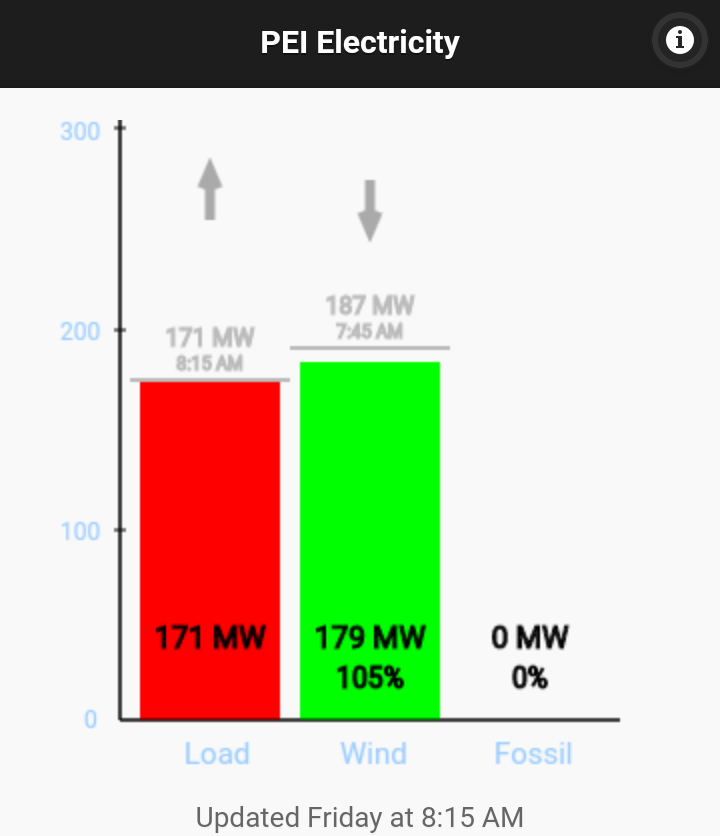
On Strawberry Hill, in the heart of the opposite of Halifax’s café district, publisher Nimbus has opened a bookshop & café called Open Book. They sell books. And coffee. And they brew up an excellent iced tea.
On a corner of the straws-and-napkins counter I found this tiny handbill for Costas Halavrezos’ Book Me!.
Costas, ex- of the CBC, has been missing from the airwaves for too long; I’m loading up the car with Book Me! episodes for the drive home to PEI.
Hilton operates 13 hotel brands, helpfully thumbnailed here. The DoubleTree brand is listed there in the “upscale” category, and is described by Hilton like this:
Warm. Comfortable. Friendly. Providing true upscale comfort to today’s business and leisure travelers.
DoubleTree’s strategy to grow the brand has been to convince operators of other brands to switch flags. This is in contrast to brands like Marriott or Sheraton which rely on new construction to grow their footprint.
And this is true in the case of the DoubleTree Dartmouth where I stayed last night, a Holiday Inn in sheep’s clothing; I know this because Oliver and I stayed here in 2002, the first time we’d left Catherine to her own devices. And because there are still vestigial Holiday Inn “no parking” signs in the back-back parking lot.
You can convince an operator to switch flags, but you can’t drum the essential Holiday Inn out of the Holiday Inn, and so this DoubleTree feels kind of like a faded movie star, with a lot of veneer and spackle to convince us that it deserves the “upscale” slotting.
I am here because the Halifax hotel market has gone crazy: it used to be easy to find a Halifax hotel room for under $200 and, if you booked through a consolidator, for under $100. I paid $207 for this room on Hotwire, and it was the cheapest room I could find in the city that wasn’t in the Stardust Motel on the road to Bedford.
But, despite the peeling paint and the toll plaza proximity, I opted to make the best of a bad thing, and discovered the following nearby delights.
Just down the hill, toward downtown Dartmouth, is St. Paul’s Cemetery. It’s easy to miss, as it’s hidden in a residential area and built into the side of a hill.
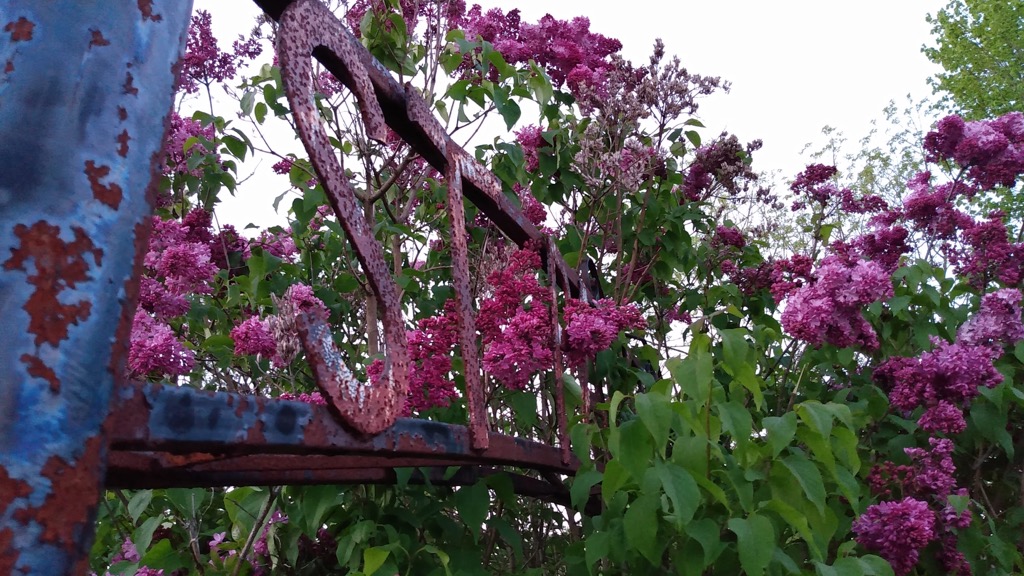
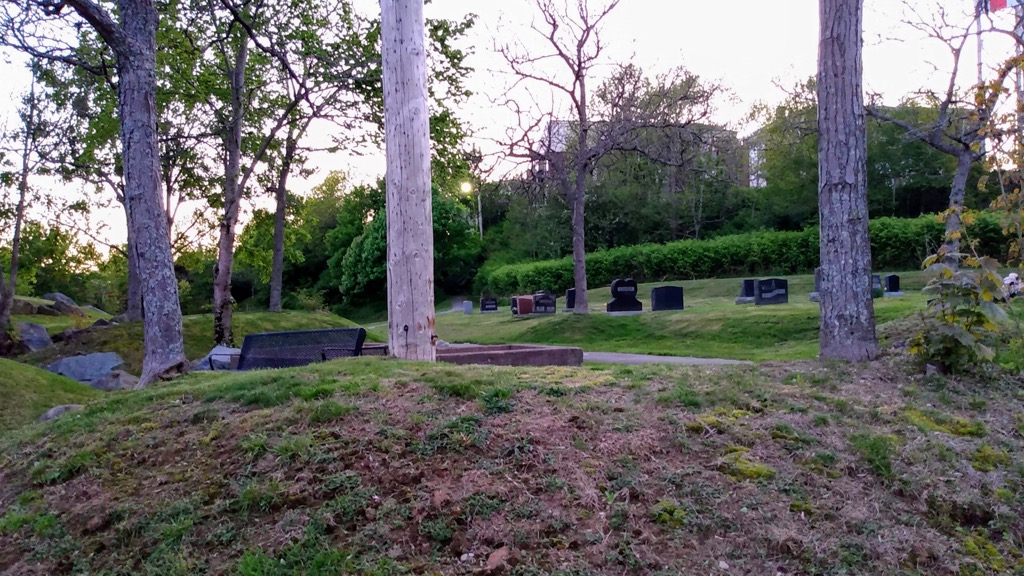
There are a mixture of very old and relatively new gravestones in the cemetery, including one for Aquila Maud Chapman Freeman, born 1907, died 1986, on the reverse of which is this puzzle:
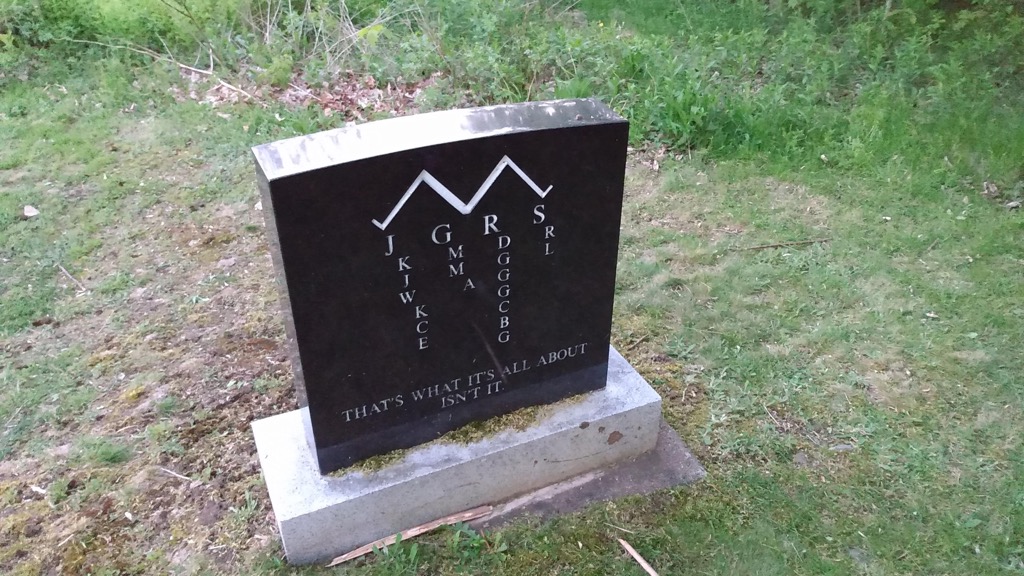
On the other side of the road is Dartmouth Common, a large and rambling hillside green space surrounded by a fence that’s dotted with memorial plaques like this one, “in memory of John and Isabella Moir, by their Daughter Olive.” Which sounds like the title of a J.D. Salinger short story.

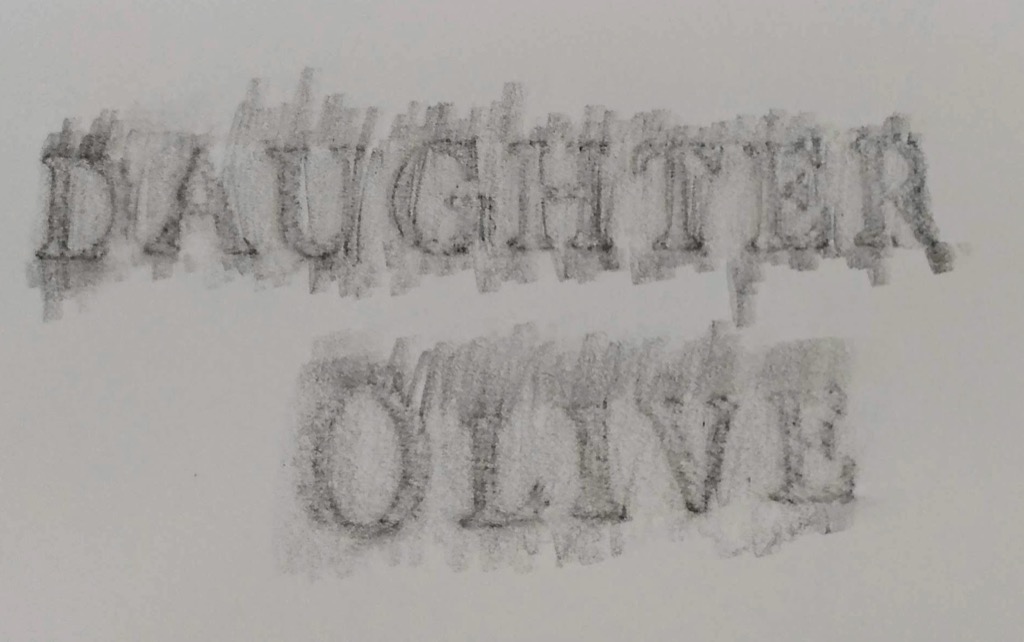
This morning I walked across the opening to the bridge toll plaza next door to Bagel Montreal Style and had a Zatar-spiced bagel that was, indeed, Montreal-style.
For my morning coffee I walked through the aforementioned Dartmouth Common to Two If By Sea. As finding parking near there as been a perpetual problem for us over the years, walking proved to be a much more relaxing approach, and it only took me 15 minutes in each direction. Along the way I got a fantastic view of the Halifax skyline:
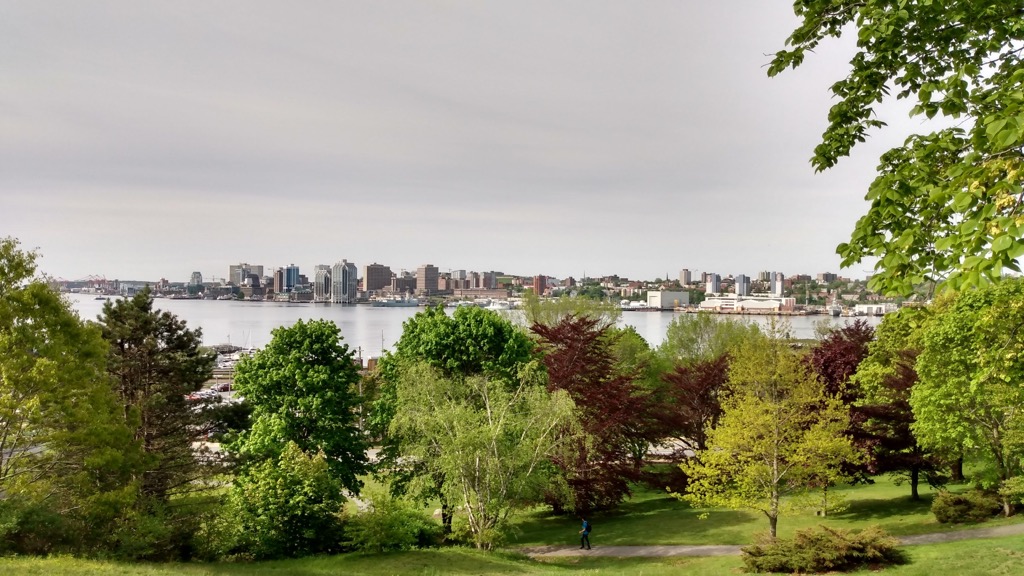
As I drank my cappuccino out front, I made a sketch of the Quaker House across the street:
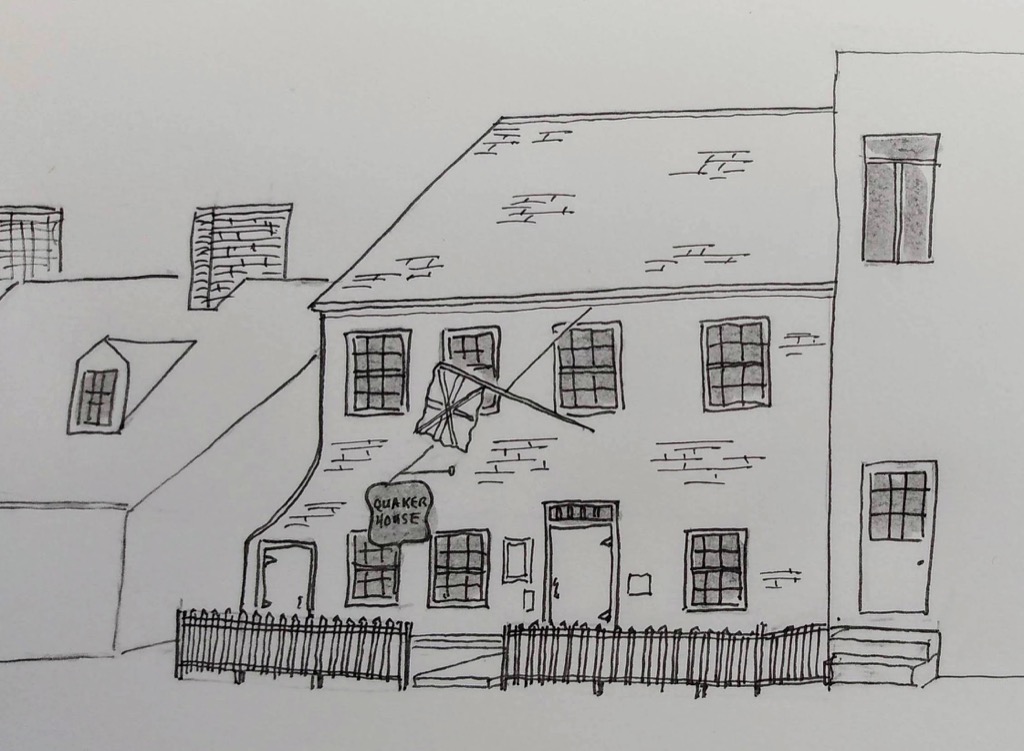
On the walk back through Dartmouth Common I spotted the Park Avenue Community Oven, which deserves further investigation on my next trip:
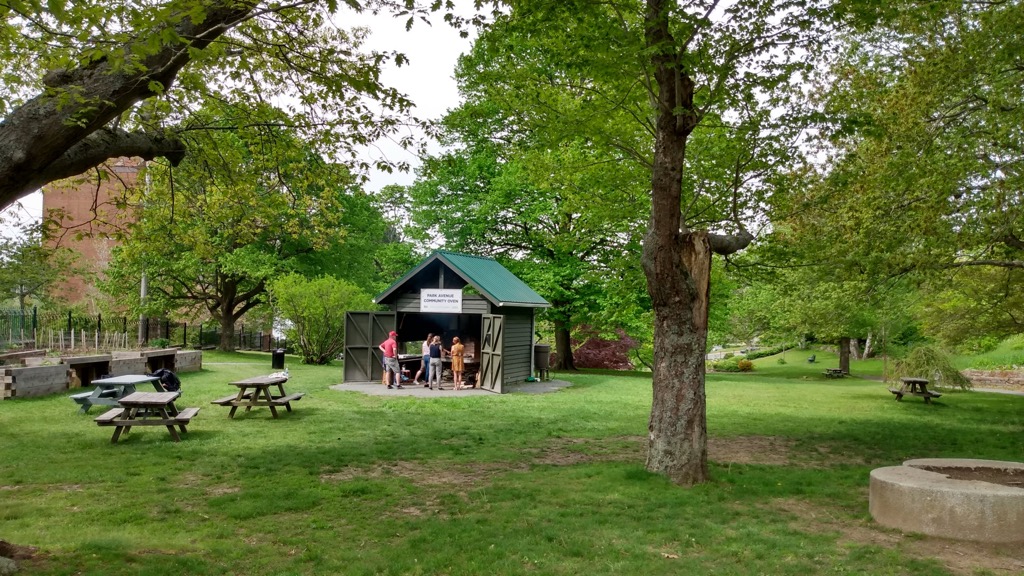
My psychogeographic wanderings prove that even in the faux-upscale confines of an evening in the DoubleTree there is beauty to be found.
My time in Dartmouth is drawing to an end; I’m off to shop for electric bicycles, and then back to PEI this evening. I decided to do the sensible thing and call Enterprise to extend my reservation into the evening so I don’t have to rush back, so as long as I time things to avoid moose-dusk, I should do just fine.
I type this from an easy chair in the lobby of the Killam Memorial Library at Dalhousie University in Halifax.
I am here in Halifax because today was a day of returning Crafting {:} a Life participants to their home jurisdictions: Juliane to Halifax to continue her Canadian journey, Morgan to YHZ to fly home to Berlin, Olle and Luisa to the bus in Sackville earlier today (where they traveled to YHZ themselves, for an earlier flight).
Because I am me, I thought it was a perfectly acceptable idea to agree to deliver a presentation to the Atlantic Association of Planning Technicians in the middle of this logistically complex week. It hardly seemed reasonable to ask they of the AAPT to reschedule their annual conference on account of me being exhausted from hosting our unconference.
The AAPT’s conference was, innovatively, bi-provincial, switching sessions back and forth between Sackville (New Brunswick) and close by Amherst (Nova Scotia). My session was in Sackville, on the beautiful campus of Mount Allison university.
After dropping Olle and Luisa off at the bus, and setting Morgan and Juliane loose on the town, I sought out my venue, and, it turns out, arrived about an hour early. So I set out to explore the campus.
I did not have to go far to find wonders: just across the path I found the Mount Allison Chapel, a remarkable 1964 building that took my breath away:
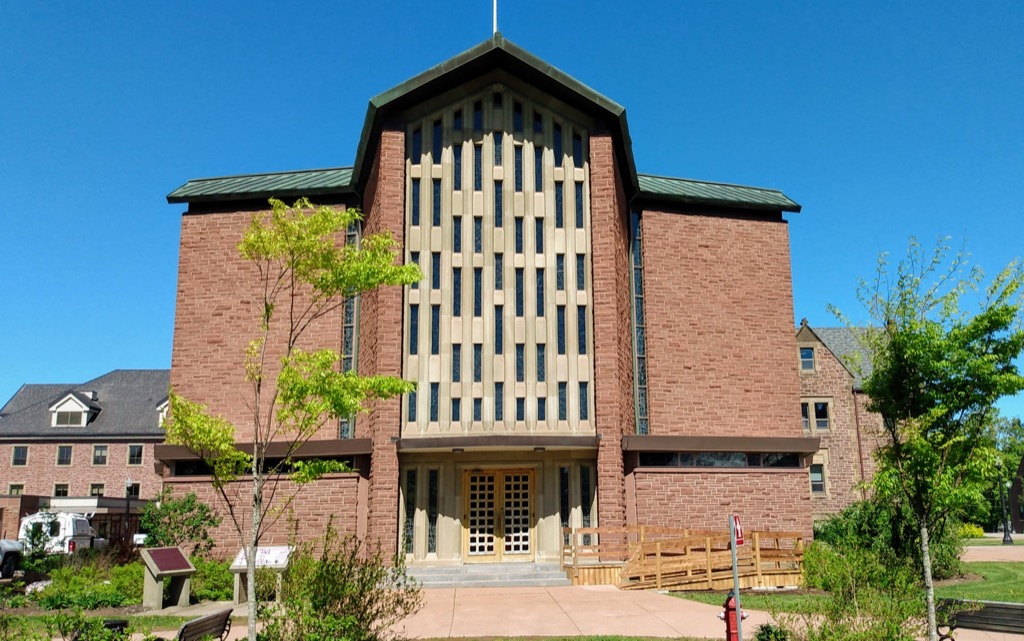
The chapel is entered through one of three sets of heavy, colourful doors:
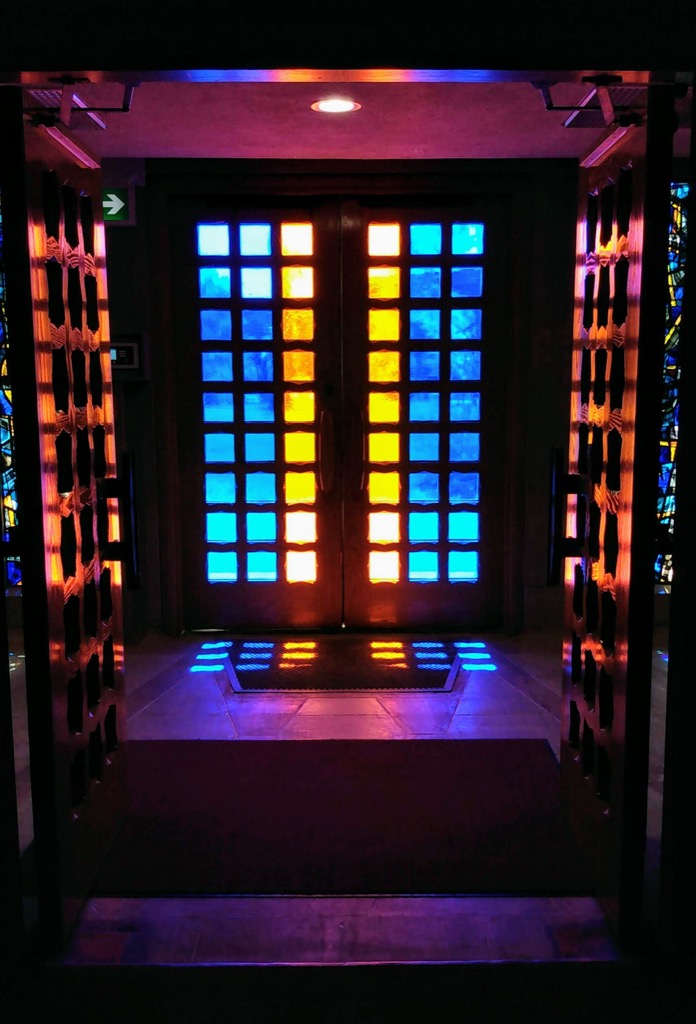
Because, apparently, I have become the kind of person who can strike up impromptu conversations with strangers, shortly after entering I found myself in conversation with The Rev. John C. Perkin, the University Chaplain. I didn’t know this at the time: he appeared to be no more than a particularly knowledgeable-about-the-chapel regular person (excellent qualification for his job). We had a delightful chat about the chapel’s architecture, history and contemporary use.
Emerging from the chapel I realized that, despite my feeling that I needed to hurry to my talk, I still had 30 minutes left, and so I walked next door to the Owens Art Gallery, where, again, I chatted, this time with the person at the front desk, who ushered me into the collection, and, later, answered some questions (like “why did the Graduate Self-Portraits project stop in the 1960s?”).
The gallery sports a permanent homage to Alex Colville, along with temporary exhibitions by Carrie Allison, Alisa Arsenault, Maryse Arseneault, Rémi Belliveau, and Herménégilde Chiasson.
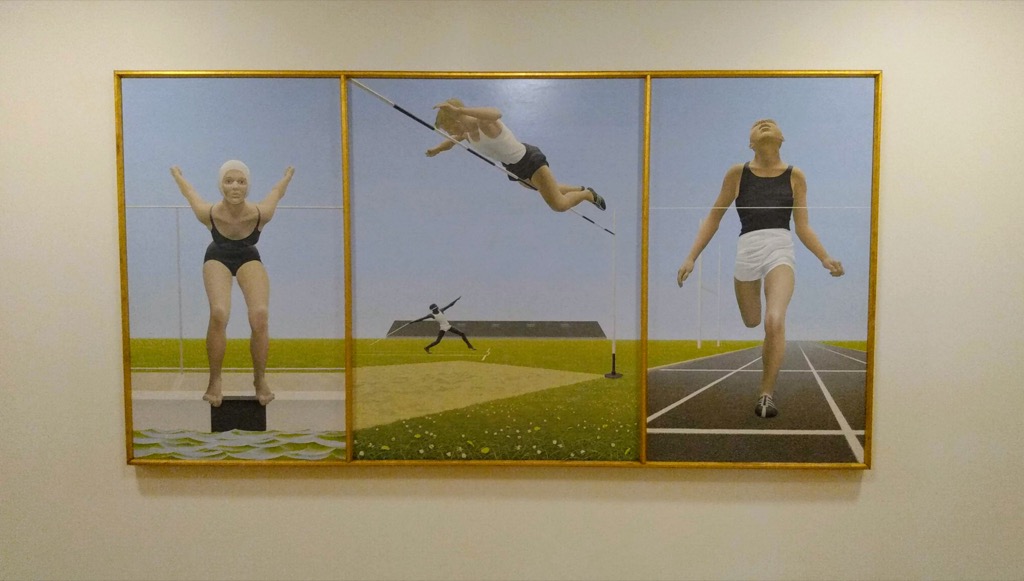
Alex Colville, Athletes, 1961
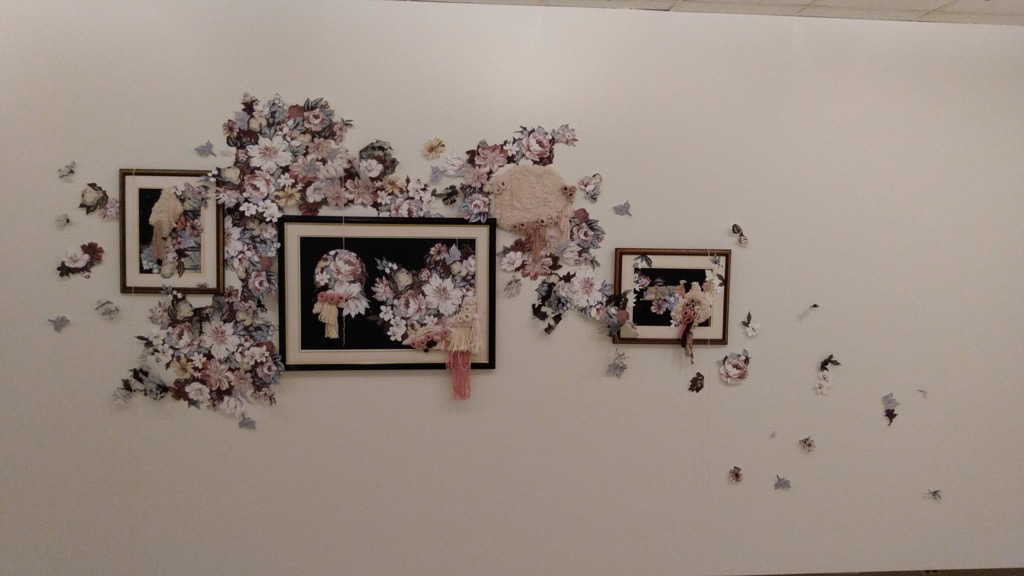
Alisa Arsenault, Still Life (or the Nesting of Memory), 2019
In the lobby there’s also a “Tiny Zine Library” (which is something every art gallery should have), as well as the aforementioned Graduate Self-Portrait collection:
Each year, in celebration of Spring Convocation and Alumni Reunion Weekend, the Owens Art Gallery displays self-portraits from the Graduate Self-Portrait Collection. From the late 1940s until the mid 1960s, Mount Allison University students in Fine Arts were required to paint a self-portrait in their fourth year, which they then submitted as their “Diploma Piece” before receiving the Bachelor of Fine Arts Degree. The portraits were to be life-sized, painted in oil on canvas or board, and measure 40 x 30 inches. An important archive of the Fine Arts Department, this collection consists of approximately fifty paintings that are now permanently housed at the Owens Art Gallery.
(The answer to my “why did it stop?” question was, in essence, “the 1970s came along and things got weird.”)
I didn’t have nearly enough time to enjoy the gallery fully, but I got a good taste, and the resolve to return on my next trip.
Emerging back into the crisp morning, with still a few minutes to go, I decided that it would be a nice gesture to build news of my discovery of Mount Allison campus treasures into my talk.
But how to get the photos from my Android phone onto my MacBook Air with my slides?
Eduroam to the rescue!
Eduroam being a system that, in essence, means that if you have network credentials at one university, you can use the wireless network at any other university. So, after uploading the photos to Google Photos via LTE on my phone, I pulled out my laptop, set it on the sidewalk and opened it up, found there was wifi with SSID of eduroam available, and authenticated with my University of Prince Edward Island credentials. Blamo: online!
I grabbed the photos, slotted them into my slide deck, and 5 minutes later I was in room 108 of the Dunn Building delivering my talk, Collecting and Visualizing Real Time Environment Data in the City of Charlottetown (slides), with a brief introductory diversion to point attendees at the chapel and the gallery, perhaps destinations for their generous 90 minute lunch break.
That I am sitting at Dalhousie University, some hours later, assembling this blog post, is also due to Eduroam, as Dal too is a participant in this great cooperative effort.
I am typing, at Dalhousie, partly because I arrived during the crazy-to-an-Islander Halifax rush hour, and have no wish to brave the traffic over to Dartmouth to get to my hotel, and partly because, suddenly devoid of my crew of European friends, I have sought solace in the anchoring port of the library.
I am overnight here tonight, e-bike shopping in the morning, and then back to the Island tomorrow afternoon.
I miss my friends dearly already; it will be good to have the airlock of an exotic Halifax rest to work through that.
Earlier this spring Oliver and I walked into the Sobeys grocery store on Allen Street in Charlottetown on a Tuesday night.
As soon as we walked in the door I noticed that something was different: the lights were lower, there wasn’t any Muzak, and I didn’t hear any announcements over the public address system.
It was as if Sobeys had opted to remove a bunch of the really annoying things about being in the store, things that we might not be completely aware are annoying until they’re removed.
It turns out that we had, by happenstance, walked into Sobeys during the two hour period, every Tuesday night, when they offer “Sensory Friendly Shopping,” an initiative undertaken in cooperation with The Autism Society of PEI.
This is a great idea, and one, I am told, that may in fact be spread to Sobeys stores across Canada in the near future.
Not only is it a gift to autistic people, but it is a gift to everyone, proving, yet again, that “accessible design” is most often synonymous with “good design.”
If you get a chance to experience Tuesday night shopping at Sobeys, and you agree, perhaps you could drop Sobeys a note of thanks?

A excellent tangible spin-off of Crafting {:} a Life: Rosie has started a new blog:
Who starts a weblog in 2019? This kid, apparently.
I’m sitting on my porch in Charlottetown on a sunny Sunday morning. It’s the first day I’ve worn shorts outside this season. Everything is fiercely green and the critters sing their existence from around the neighbourhood. Most I don’t know, but I can pick out squirrels, crows, and the grackles that have nested in our eves. Sam the cat kept me company on the porch while I set up a new VM, WordPress, Apache vhosts, and SSL certs – the method I’ve chosen to do this… new blog project thing. It’s not hard for me, I’ve set up websites before, but I find it hard to get through without a checklist – my brain doesn’t hold a stack well.
There was a lot of talk about blogging at the unconference–three sessions, by my count–and I’m happy to see the corner turn from “why did blogging die when we loved it so?” to “I’m going to start a new blog!”
After watching Andrea Ledwell receive her vegan powerball at Receiver Coffee in a coffee cup on Sunday, and hearing me joke that it was intended to have something poured over, Oliver went for it today, and poured blood orange Sanpellegrino over his own powerball. We dubbed it “The Andrea” in her honour. And he ate/drank it with a demitasse spoon. Ask for it by name next time you’re in for a snack.
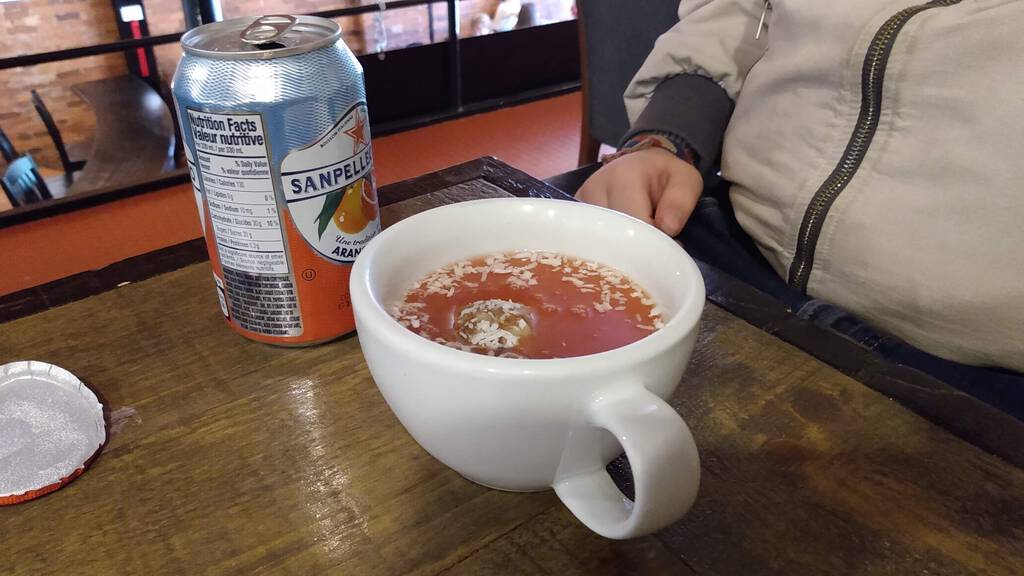
While we were waiting for the bus home today, Olle explained to me and Oliver how QSL cards work: two ham radio operators establish a radio connection, the more distant and unlikely the better; during the connection they exchange call signs, which are globally-unique and can be used to look up a postal address; to mark the magical radio connection, a printed QSL card can thus be sent, acting as a kind of award of merit for defeating geography via radio.
Olle delivered this explanation in light of Ton’s proposal:
Letterpress printed QSL cards for successfully sent and received Webmentions must be the most finely targeted joke. The audience very likely not larger than 3 people.
Being interested in Webmentions, and also being a letterpress printer, I feel an obligation to make this happen.
Here, then, are the Indieweb building blocks:
- Olle writes a blog post.
- On my blog, I reference Olle’s blog post, and so my blog sends him a Webmention.
- Olle’s blog receives the Webmention, and looks to see if he’s ever received one from me before.
- He hasn’t!
- Olle’s blog looks for a postal address h-card on my blog and, finding one, sends a mailing label to Olle by email, ready for attaching to a letterpress-printed QSL card that he can pop in the mail to me.
For this to work as outlined:
- Blog authors need to includ their postal mailing address on their blogs, marked up as an h-card. I’ve got this but not everyone does.
- The Webmention-receiving logic on blogs needs to be able to track first contact, and trigger a QSL-card-sending callback when it’s established.
- Letterpress QSL cards need to be printed. I can do this.
I agree with Ton that the audience is small. But we’ve already got 3 people, so the idea has already reached 100% of its estimated audience.
Tim Carmody, on Kottke.org, writes about pain medication; in part:
This is all to say: no, I’m not on pain medication. Yes, I’m terribly uncomfortable. No, I’m not uncomfortable enough to jump through hoops and beg for more drugs. (Maybe if I were, things would be different.) And at the times I was most uncomfortable, those were the times when medicine was the least available to me, by design.
We’ve got to get over our weird Puritanical crap about pain and pain medication, and accept the fact that in certain contexts, we need the drugs. And by “we,” I mean myself, the medical system; everybody. We can’t be responsible for the entire opioid epidemic every second of every day. Sometimes we just need to be able to go to sleep.
I’ve learned a lot about this domain in the last 5 years. The backlash against opioids, while understandable given the toll that they’ve taken, has also served to cast an unhelpful shadow over pain meds of any type. For those in chronic pain, carrying the extra weight of that shadow is the last thing they need.
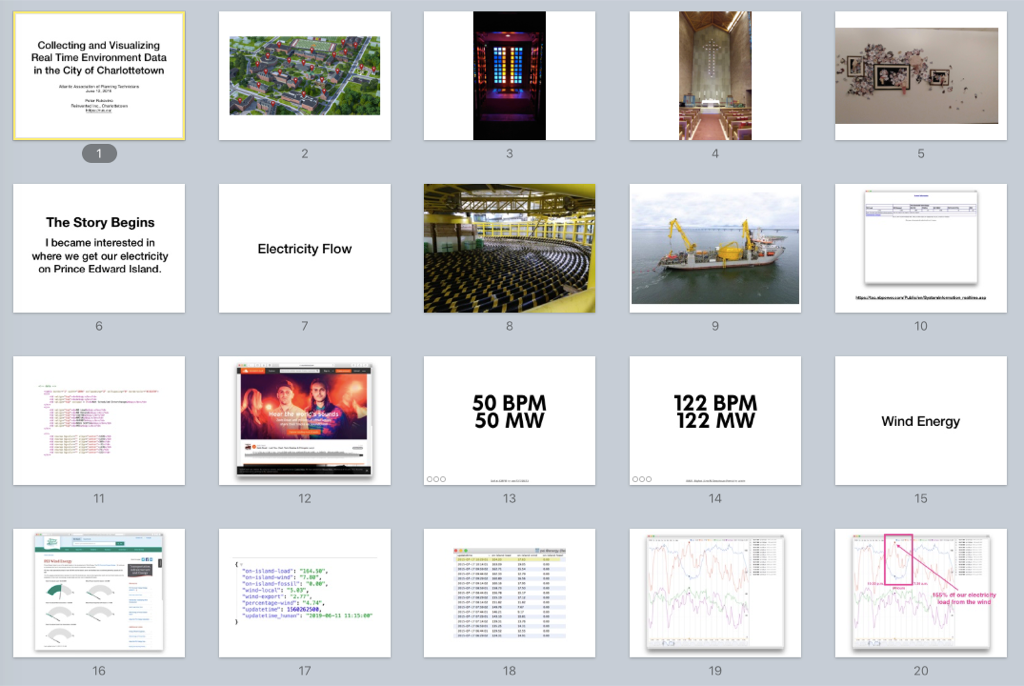
 I am
I am